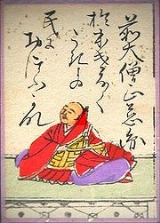
Jien
Encyclopedia
Jien (17 May 1155 in Kyoto
– 28 October 1225 in Omi
(now Shiga)) was a Japanese
poet, historian, and Buddhist monk.
, a member of the Fujiwara family
of powerful aristocrats. He joined a Buddhist monastery of the Tendai
sect early in his life, first taking the Buddhist name Dokaie, and later changing it to Jien. He eventually rose to the rank of , or leader of the Tendai sect.
He began to study and write Japanese history, his purpose being to "enlighten people who find it hard to understand the vicissitudes of life". His masterpiece, completed c. 1220, was humbly entitled, Gukanshō
, which translates as Jottings of a Fool. In it he tried to analyze the facts of Japanese history. The Gukanshō held a mappo
and therefore pessimistic view of his age, The Feudal Period, and claimed that it was a period of religious decline and saw the disintegration of civilization. This is the viewpoint generally held today. Jien claimed that changes in the feudal structure were necessary and defended the shogun
's claim of power.
As a poet, he was named one of the New Thirty-six Poetry Immortals, and was the second-best represented poet in the Shin Kokin Wakashū. He was included by Fujiwara no Teika
in the Ogura Hyakunin Isshu.
Kyoto
is a city in the central part of the island of Honshū, Japan. It has a population close to 1.5 million. Formerly the imperial capital of Japan, it is now the capital of Kyoto Prefecture, as well as a major part of the Osaka-Kobe-Kyoto metropolitan area.-History:...
– 28 October 1225 in Omi
Omi
was an ancient Japanese hereditary title denoting rank and political standing that, along with muraji, was reserved for the most powerful clans during the Kofun period...
(now Shiga)) was a Japanese
Japanese people
The are an ethnic group originating in the Japanese archipelago and are the predominant ethnic group of Japan. Worldwide, approximately 130 million people are of Japanese descent; of these, approximately 127 million are residents of Japan. People of Japanese ancestry who live in other countries...
poet, historian, and Buddhist monk.
Biography
Jien was the son Fujiwara no TadamichiFujiwara no Tadamichi
was the eldest son of the Japanese regent Fujiwara no Tadazane and a member of the politically powerful Fujiwara clan. He was the father of Fujiwara no Kanefusa and Jien.In the Hōgen Rebellion of 1156, Tadamichi sided with the Emperor Go-Shirakawa....
, a member of the Fujiwara family
Fujiwara family
The Fujiwara clan , descending from the Nakatomi clan, was a powerful family of regents in Japan.The clan originated when the founder, Nakatomi no Kamatari , was rewarded by Emperor Tenji with the honorific "Fujiwara", which evolved as a surname for Kamatari and his descendants...
of powerful aristocrats. He joined a Buddhist monastery of the Tendai
Tendai
is a Japanese school of Mahayana Buddhism, a descendant of the Chinese Tiantai or Lotus Sutra school.Chappell frames the relevance of Tendai for a universal Buddhism:- History :...
sect early in his life, first taking the Buddhist name Dokaie, and later changing it to Jien. He eventually rose to the rank of , or leader of the Tendai sect.
He began to study and write Japanese history, his purpose being to "enlighten people who find it hard to understand the vicissitudes of life". His masterpiece, completed c. 1220, was humbly entitled, Gukanshō
Gukansho
is a historical and literary work about the history of Japan. Seven volumes in length, it was composed by Buddhist priest Jien of the Tendai sect c. 1220....
, which translates as Jottings of a Fool. In it he tried to analyze the facts of Japanese history. The Gukanshō held a mappo
Mappo
The Latter Day of the Law, is one of the Three Ages of Buddhism. Mappō or Mofa , which is also translated as the Age of Dharma Decline, is the "degenerate" Third Age of Buddhism.- Tradition :...
and therefore pessimistic view of his age, The Feudal Period, and claimed that it was a period of religious decline and saw the disintegration of civilization. This is the viewpoint generally held today. Jien claimed that changes in the feudal structure were necessary and defended the shogun
Shogun
A was one of the hereditary military dictators of Japan from 1192 to 1867. In this period, the shoguns, or their shikken regents , were the de facto rulers of Japan though they were nominally appointed by the emperor...
's claim of power.
As a poet, he was named one of the New Thirty-six Poetry Immortals, and was the second-best represented poet in the Shin Kokin Wakashū. He was included by Fujiwara no Teika
Fujiwara no Teika
Fujiwara no Teika , also known as Fujiwara no Sadaie or Sada-ie, was a Japanese poet, critic, calligrapher, novelist, anthologist, scribe, and scholar of the late Heian and early Kamakura periods...
in the Ogura Hyakunin Isshu.

